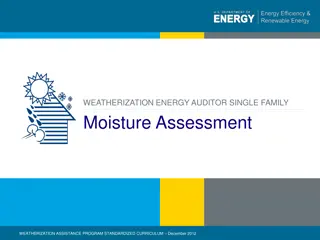Understanding Thermal Comfort in Weatherization and Energy Auditing
This content delves into the importance of thermal comfort in weatherization and energy auditing for single-family homes. It covers topics such as human thermal comfort principles, relative humidity, psychrometric charts, and factors affecting comfort like air temperature and clothing insulation. Visual aids and explanations help learners grasp the key concepts necessary for creating comfortable indoor environments.
Download Presentation

Please find below an Image/Link to download the presentation.
The content on the website is provided AS IS for your information and personal use only. It may not be sold, licensed, or shared on other websites without obtaining consent from the author. Download presentation by click this link. If you encounter any issues during the download, it is possible that the publisher has removed the file from their server.
E N D
Presentation Transcript
WEATHERIZATION ENERGY AUDITOR SINGLE FAMILY Comfort and Climate WEATHERIZATION ASSISTANCE PROGRAM STANDARDIZED CURRICULUM December 2012 1 | WEATHERIZATION ASSISTANCE PROGRAM STANDARDIZED CURRICULUM December 2012 eere.energy.gov
Learning Objectives COMFORT AND CLIMATE By attending this session, participants will be able to: List the basic principles of human thermal comfort. Describe relative humidity. Demonstrate how to use a psychrometric chart. 2 | WEATHERIZATION ASSISTANCE PROGRAM STANDARDIZED CURRICULUM December 2012 eere.energy.gov
Comfort Defined COMFORT AND CLIMATE Most humans share a general range of comfort. 68 F 85 F 15% to 75% relative humidity (RH) Air movement speeds heat transfer Mean radiant temperature Activity level Conditioning matters! People grow accustomed to heat, cold, and humidity. 3 | WEATHERIZATION ASSISTANCE PROGRAM STANDARDIZED CURRICULUM December 2012 eere.energy.gov
Factors in Thermal Comfort COMFORT AND CLIMATE Environmental: Air temperature Relative humidity (RH) Air motion Mean radiant temperature Personal: This chart shows the interaction of two of the environmental factors in thermal comfort. Clothing insulation value Metabolic rate 4 | WEATHERIZATION ASSISTANCE PROGRAM STANDARDIZED CURRICULUM December 2012 eere.energy.gov
Visualizing Thermal Comfort COMFORT AND CLIMATE Image courtesy of 5 | WEATHERIZATION ASSISTANCE PROGRAM STANDARDIZED CURRICULUM December 2012 eere.energy.gov
Air Temperature COMFORT AND CLIMATE Photos courtesy of Bill Van der Meer While humans are generally comfortable between 68 F and 82 F, relative humidity affects the comfort range. 6 | WEATHERIZATION ASSISTANCE PROGRAM STANDARDIZED CURRICULUM December 2012 eere.energy.gov
Relative Humidity COMFORT AND CLIMATE Relative Humidity (RH) The amount of water vapor contained in a given volume of air relative to the total amount of water vapor it is capable of containing, expressed as a percentage. 100% RH = Condensation Humans are comfortable at 15% - 75% RH, depending on activity level. Tolerance to upper limit drops as activity level rises. Below 15% RH, medical issues arise. Photos courtesy of Bill Van der Meer 7 | WEATHERIZATION ASSISTANCE PROGRAM STANDARDIZED CURRICULUM December 2012 eere.energy.gov
Measuring Relative Humidity COMFORT AND CLIMATE Sling Psychrometers Two thermometers side-by-side One is wrapped in wet wick (wet bulb), the other is dry (dry bulb) Spinning it around speeds temperature stabilization Plot wet bulb and dry bulb temperature on psychrometric chart to determine dew point and RH. Photos courtesy of Bacharach Sling Psychrometer 8 | WEATHERIZATION ASSISTANCE PROGRAM STANDARDIZED CURRICULUM December 2012 eere.energy.gov
Psychrometric Chart #1 COMFORT AND CLIMATE Dry bulb = 80 Wet bulb = 66 Dew point = 60 RH = 50% Grains of water per pound of dry air Table created for the US DOE WAP National Standardized Curricula 9 | WEATHERIZATION ASSISTANCE PROGRAM STANDARDIZED CURRICULUM December 2012 eere.energy.gov
Psychrometric Chart #2 COMFORT AND CLIMATE 156 156 Grains of water per pound of dry air 78 Table created for the US DOE WAP National Standardized Curricula 10 | WEATHERIZATION ASSISTANCE PROGRAM STANDARDIZED CURRICULUM December 2012 eere.energy.gov
Psychrometric Chart #3 COMFORT AND CLIMATE Grains of water per pound of dry air Table created for the US DOE WAP National Standardized Curricula 11 | WEATHERIZATION ASSISTANCE PROGRAM STANDARDIZED CURRICULUM December 2012 eere.energy.gov
Psychrometric Chart #4 COMFORT AND CLIMATE Grains of water per pound of dry air Table created for the US DOE WAP National Standardized Curricula 12 | WEATHERIZATION ASSISTANCE PROGRAM STANDARDIZED CURRICULUM December 2012 eere.energy.gov
Psychrometric Chart #5 COMFORT AND CLIMATE Grains of water per pound of dry air Table created for the US DOE WAP National Standardized Curricula 13 | WEATHERIZATION ASSISTANCE PROGRAM STANDARDIZED CURRICULUM December 2012 eere.energy.gov
RH Things to Remember COMFORT AND CLIMATE Warm, wet air contacting cold surfaces creates condensation instantly. Cold winter air typically contains very little moisture. When that air is heated, the RH drops even further. RH below 15% can lead to respiratory problems, failure of furniture glue and other problems. 14 | WEATHERIZATION ASSISTANCE PROGRAM STANDARDIZED CURRICULUM December 2012 eere.energy.gov
Summary COMFORT AND CLIMATE Air temperature, movement and relative humidity effect thermal comfort. Ideal conditions: o Heating season: 68 F, 20% to 40% RH. o Cooling season: 75 F, keep RH below 60%. Control drafts. Minimize temperature swings. Be aware of mean radiant heat transfer. Plot wet and dry bulb temperatures on a psychrometric chart to determine dew point and relative humidity. 15 | WEATHERIZATION ASSISTANCE PROGRAM STANDARDIZED CURRICULUM December 2012 eere.energy.gov























